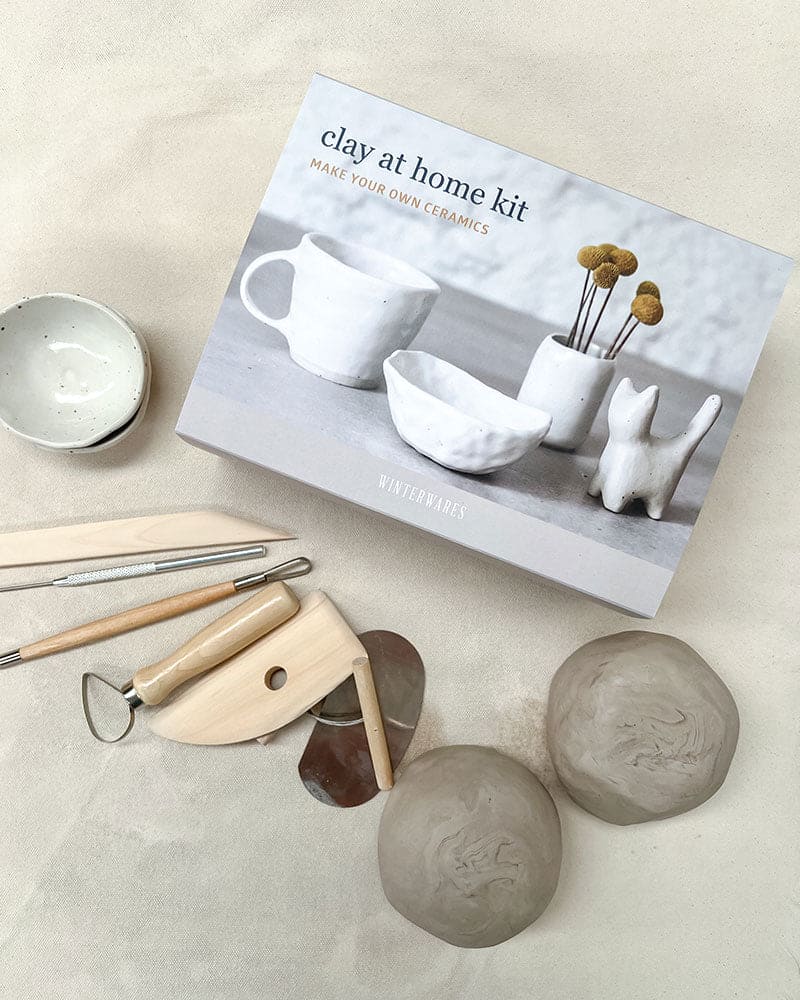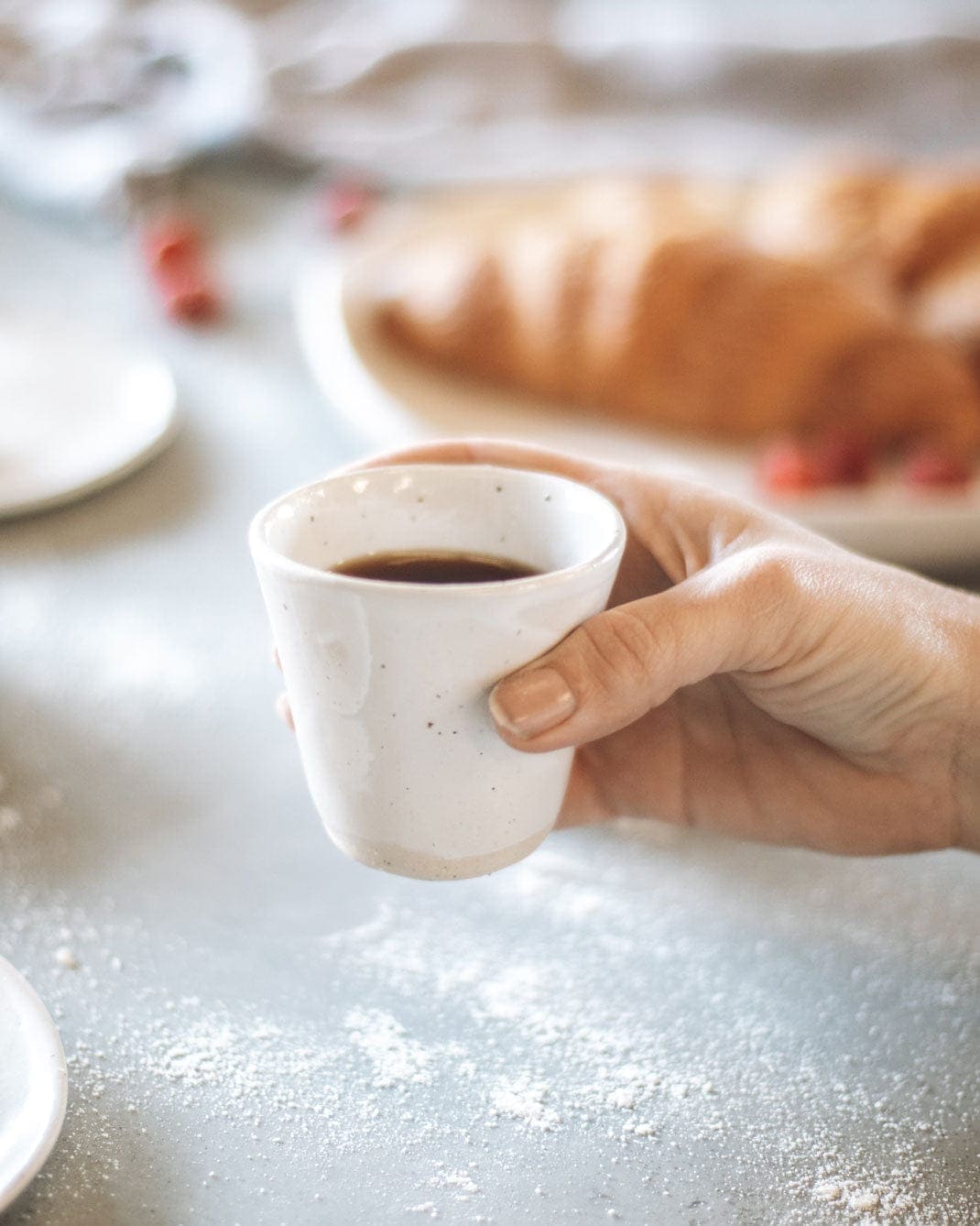Tactile calm, the Winterwares pottery studio
Leigh-Ann Gemson is an interior designer with a passion for creating and finding spaces that enhance well-being through conscious design. She came to visit the Winterwares studio and chat with me about my story and how my space informs my work.
Words by Leigh-Ann
Sometimes we reach a point in life where we feel like we have nothing left to give. Characterised by exhaustion, overwhelm and anxiety, quite often this experience compels us to stop. And begin again. But begin differently. In moments like these, it becomes apparent what is important to us and what is not. With little energy and reserves, we choose carefully what to focus our efforts on and let the rest fall by the wayside. Driven by a need to find new meaning and hope, to rebuild ourselves, we might try something we’ve not done before. We might start making something that we’d always been curious about. For Simone Nabholz that something was ceramics.
One of the first objects Simone made was a bowl. Today that bowl is one of Winterware’s most popular items – the Everyday Bowl. It’s a symbol of nourishment and slowing down to savour the simple pleasure of eating beautiful food. The Everyday Bowl sits alongside a growing collection of understated, handmade pieces in the Winterwares range.
Simone’s stoneware vessels are characterised by uncomplicated shapes with a sturdy weight. They exude a tactile sense of calm. The philosophy of doing less but doing it with wholehearted intent has become a way of life for Simone. Through her ceramics and workshops, Simone invites others to come and enjoy mindfully making an object which will spark joy and bring newfound meaning to everyday rituals.
I visited Simone in her studio one morning to learn more about where Winterwares are made. As one would expect, the space is calm and serene. Filtered light streams through the saw-tooth roof window onto the muted grey cement benchtops, contouring a group of analogue tools central to the craft. Music hums and a candle burns amidst the making as mounds of clay are rolled flat by heavy canvas mats then draped on to plaster moulds to be shaped.
Family connections are woven into her work and studio. Simone’s father built her slab roller and her mother works with her in the business. Collectables which her in-laws gathered during their travels around the Middle-East sit on top of some of the many shelves in the studio.
Please enjoy reading my Q&A with Simone.
Leigh-Ann (LG): How long have you been in this studio? How has your space evolved in that time?
Simone (SN): I moved into my studio in February 2016, I was one of the first to move into Stackwood, (the co-op warehouse where my studio resides). It was an empty shell when I took the lease, the concrete floors and plywood walls painted all bright white. The first thing I moved in was my concrete sink, it’s at least 40 years old and was tucked away in my original 1950’s cottage when I bought it. I’m so happy it’s got a new purpose and is used again every day. When I first moved in I was on a shoestring budget, I had my essential pieces of furniture, high tables and a few stools, a couple of trolleys to hold my jars of pottery tools and lots and lots of buckets. Most of those things I foraged off gumtree and verge collection. My biggest investment was my shelving. A ceramics studio can never have too many shelves. Over time I’ve bought more and more shelves!
LG: What are your favourite things about your studio space?
SN: The feeling you have when you’re in here. It’s designed to be a calm space, a sanctuary away from the busy world outside. I find it’s even a sanctuary away from the busy thoughts in my head. When I’m working with clay it’s so grounding. There’s meditation in the movement of making pottery when my hands are busy, my mind is quiet. The light is so beautiful, I have streams of natural filtered light pouring into the room all day. All the colours in the room are muted and the materials are natural, which makes the space feel peaceful.
LG: How are the philosophies embodied by your business reflected in your studio space?
SN: I believe that ordinary objects can elevate our lives, with their beauty and integrity. It’s so important for me to choose less and choose well. All the things I bring into my studio fit this idea, for instance, if I’m buying a pair of scissors, I’m not going to choose a cheap plastic pair – because there is no joy in using them. I’ll choose a pair that is brass, or vintage, or hand-forged, something about it that connects me to the maker or the material. In that way, each item I use on a day to day basis brings me a sense of contentment every time I look at it or hold it. The philosophy of Winterwares is to slow down and enjoy our simple, daily rituals. When I enter the studio space I have a little routine each morning that sets me up for the day. The music goes on, I light one of my candles, I brew a cup of chai and tie my apron and then I’m ready to make.
LG: I’m intrigued by how the environments we inhabit influence our state of mind, thoughts, emotions and behaviours and vice-versa. In what ways would you say your space has an effect on your mood and wellbeing?
SN: My space makes me feel calm and grounded and I see how it has this same effect on other people who come into my studio. I find that people feel safe to share whatever is weighing them down mentally and emotionally when they’re here. I’ve had people share things that they’ve never told anyone and they say there’s something about the vibe in here that makes them feel comfortable and at ease. Winterwares was born from a desire to slow my pace of life, to get back to what’s most important in my life and figure out what’s unnecessary.
LG: Ceramics engenders a sequence of processes in order to produce vessels, these processes dictate a certain order in a space. How have you set up the space to support and streamline the production of your ceramics?
SN: As I’ve spent more time here I’ve refined my workflow and my processes so that I can use the space I have most efficiently. About a year ago I expanded the space by knocking down a wall and taking over the studio next door. Now I have designated work areas for different functions; making greenware, glazing and packaging.
LG: Ceramics is a highly tactile craft, what are the main surfaces and materials you come into contact with on a daily basis?
SN: My hands are in clay and water all day. The surfaces that I work on are fibre cement sheets, they don’t break down from all the water on them and the clay doesn’t stick to it. It’s really important to me to use materials that are beautiful, I choose natural materials as much as I can. I try to limit the use of plastic, my tools are made from wood, metal, paper, glass and fabric. Everything in my studio serves a purpose, it’s all lovely to look at and functional.
LG: Do you deliberately incorporate sustainable practices in the running of Winterwares?
SN: I feel that I can always improve on what I’m doing to be more sustainable. With my packaging, I use eco-wrap which is a paper alternative to plastic bubble wrap. I reuse boxes for shipping. I’m in a warehouse that gets lots of deliveries and they save up all their boxes for me to reuse. I’m really interested in how a business can use its resources to do good things in the local community. I always look to support local for my supplies, for making and packaging. The courier company I use to send all my orders is Australia’s first carbon-neutral delivery service. I like to support other companies that are doing great work, brands such as Who Gives a Crap, Thank You and Sendle are the kinds of conscious businesses that I support by being a customer of theirs.
LG: Have any other recycled materials been used to construct your space or equipment?
SN: I’m so lucky, my Dad is a carpenter and he’s custom-built so many things in my studio. The blocks supporting the table came from the house renovation he did for me a couple of years ago. It was one of the beams in the roof of the house that he took out when he knocked out a wall. He made my slab roller and it’s incredible. I was rolling out clay with a rolling pin, painstakingly slow and he quietly decided he’d make me a slab roller. He came in one day with this gift he’d made. It’s the most wonderful invention! It uses reclaimed timber and an old car steering wheel, my brother works at a steel cutting company and he made the steel roller pieces. It’s the single best thing I have to improve my productivity, that and the pugmill I found in an op-shop, but that’s a great story for another time.






